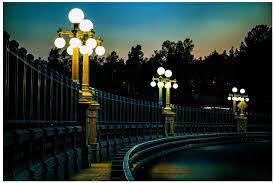THE QUEEN AND ME By Chip Jacobs
Pasadena’s fabled Colorado Street Bridge consumed eleven thousand cubic yards of cement, each yard weighing roughly two tons, during its lengthy—and sometimes harrowing—construction at the onset of the automobile era in 1912 and 1913.
During construction of this historical novel, there were points when I felt like one of its hefty, Beaux-Arts columns were strapped around me.
The structure still curving over the Arroyo Seco, you see, isn’t only an ode to bravura engineering of the Progressive Age, when steel-reinforced concrete heralded a modernization kick soon to remake cities, architecture, and this futuristic concept known as freeways. The bridge rested in the same vicinity many of my ancestors have resided in since my maternal grandfather, Hollywood musician Lee Zahler, relocated here from New York’s Tin Pan Alley in the early 1920s.
Given that familial connection—and the edifice’s split personality as both a noir-ish beauty emblematic of Pasadena’s grandeur and one of the most blood-soaked places in the San Gabriel Valley—penning a historical novel about the bridge wouldn’t be, as they once said in the day, duck soup. On the contrary, it loomed as a weight-bearing excursion through a minefield. Nobody calls the roadway that helped braid Los Angeles’ two great valleys together by its formal appellation. They call it “Suicide Bridge” on account of the more than 150 souls who’ve leapt to their deaths from its creamy-gray ledges.
Nonetheless, I’d been mesmerized by this bridge—arguably Pasadena’s foremost beauty queen, sorry Rose Princesses—since I was a partying, girl-crazy prep high school student. On the night I crumpled the back of my parent’s Pontiac Grand Safari by stupidly backing into a buddy’s car in the parking lot below her, I swear I could feel the queen staring down at me, as though she already knew we’d enjoying a literary rendezvous later.
It wasn’t a simple journey to her. All I knew, as a former journalist and non-fiction author, was that my maiden stab in fiction would somehow involve a quixotic dreamer and a rascally dog able to occasionally read his companion’s oft-distracted mind. The spark for that concept shared my last name, just not my identity. It was my big brother, Paul, who scolded me that I was squandering my unrelenting sarcasm and affection for irony

and absurdity by genre jumping, from biography to environmental to true crime in the non-fiction universe. Go with your nature, he said, and your love of the pureness of dogs. What’s annoying at family get-togethers might appeal to certain readers.
Not long after, in the course of freelancing an unrelated topic, I stumbled across an afterthought mention in a Pasadena coffee-table-type book about a gruesome construction accident that struck the bridge near quitting time on August 1, 1913. Soon I was obsessed about how the bridge saved repeatedly by good-hearted preservationists, the bridge whose romantic sightlines prop up local art galleries and organizations had such tragic
origins. It just goes to show: the best story is the one you never set out to write.
I started kicking up dirt like an unsupervised Labrador, resurrecting details in the microfiche cubbyholes at the Pasadena Central Library and the subterranean stacks at the Pasadena Museum of History. I downloaded old engineering stories that tested the tensile strength of my liberal-arts brain.
What I discovered about the inception of this old gal was juicy—it’s own gas-lamp soap opera rampant with feuds, missed deadlines, intrigue, and scant justice for those responsible for that semi-collapsed arch, which took a trio of innocent men to their demises from more than a hundred feet in the air. The citizenry, back in a time of a lapdog journalism, knew precious little about this strife and secrets, including how the tycoons living in mansions on the Orange Grove Boulevard’s “Millionaire’s Row” influenced the bridge’s design.
A pilot light flicked on in me: this is the backdrop I coveted for my man-dog morality tale.
I probably bought Jeff Bezos a tony, new blazer with the twenty-odd books about the city and general atmosphere I purchased off Amazon. From them and other sources, I saw that turn-of-the-century Pasadena held a constellation of big names I could use: Teddy Roosevelt, muckraker Upton Sinclair, Renaissance Man Charles Fletcher, and Adolphus and Lillian Busch, whose magical gardens of terraced slopes, fairytale huts, and winding paths were once crowned “the eighth wonder of the world.”
Looking back, I realize I’d collected the essential ingredients for a historical novel: romance, parasol-twirling splendor, political trickery, and hidden conflict surrounding a famous bridge infamous today for rampant suicides and ghosts.
But what I was missing could’ve filled a dozen concrete vats. In early versions of Arroyo, my characters were feebly drawn individuals in the thick of either dangerous or entertaining circumstances. My celebrities were gaudy showpieces who played no role in advancing or arresting my protagonist, his suffragette girlfriend or his precocious dog. The bridge itself had nothing to add – a stoic royal indifferent to the escapades created in her name.
Around the time I was about to start writing, my elderly father’s health nosedived, and I used his death as a pretext to delay the inevitable rolled-up sleeves grind. So, I disgorged an overwrought 30,000-word outline instead of a first draft doomed to fail. When I finally produced a miserable second draft, my editor critiqued my book-in-progress as “original,” “fun” and nowhere ready for publication.
He was right. I couldn’t tackle such an important and uber-delicate subject with a tissue- thin storyline where events subsumed the characters’ journeys. And I’d be damned if I was going to make the Colorado Street Bridge’s association with suicide the centerpiece when the better story was the provenance of her dark alter-ego.
A gutless historical novel about my city’s most enigmatic creature: what was I thinking?
It was a return to basics. I buried my nose into writers who’d brought history in Technicolor brilliance: Pete Dexter (Deadwood) and T.C. Boyle (Road to Wellville). I studied how they developed their heroes, black hats, and side characters within the realm of their time. I read John Irving’s latest, Avenue of Mysteries, to decipher how he so effortlessly integrated magical realism into his engaging morality play.
Still, the writing wasn’t as simple as the inspiration I drew from Messrs Dexter, Boyle, and Irving. It was perspiration time – no more Internet distractions, excuse making, or delusions my story would materialize, to quote John Lennon, “on a flaming pie.” I had to accept I’d fail in draft after painful draft, in storylines that tried to be all things to all people, in prioritizing clever phrasing over crisp exposition. And when the sheer tonnage of my ambition put my bone strength to the test, I quaffed Diet Coke and reminded myself that my novel demanded to be about unique characters living fishbowl existences within little-known history.
For four months starting last Thanksgiving, I buckled down like I had on no other book, pushing myself to the brink (while paying for my previous posturing as a future novelist). I made myself a rumor to my family. I forsook weekends, favorite Netflix shows, vacations, and the Pasadena sun. I cut, edited, and revised through flu-bugs and a trigger- finger caused by repeated use of the delete key.
By Easter, I’d lopped twenty thousand words and, with the assistance of my patient editor and understanding publisher, created a storyline far more nuanced and magical than I ever dreamed I could.
Suddenly, the concrete felt a whole lot lighter. I hope I made Pasadena’s weighty queen proud as her un-sought biographer.
Author and journalist Chip Jacobs grew up in northeast Pasadena. He’s written four non-fiction books, and his reporting has appeared in the Los Angeles Times, the Chicago Tribune, The New York Times and other well-known publications. Arroyo is his first novel.
Note: this essay, first published on the blog A Writer of History in November 2019, has been slightly amended. Link to the original version: https://awriterofhistory.com/2019/11/14/pasadenas-infamous-suicide-bridge-by-chip- jacobs/
Related Posts
The Tree and the Voice and Writing a Novel
"Later Days" began when a brilliant, dying friend asked me…
From the Department of Unexpected: “Later Days” Wins General Fiction Prize at the American Writing Awards!
And, in another humbling development, it was also named…
“The Lost Art of Album Release Parties” – Boomer magazine
We hustled into my room, nodding at the familiar, Jimmy…




